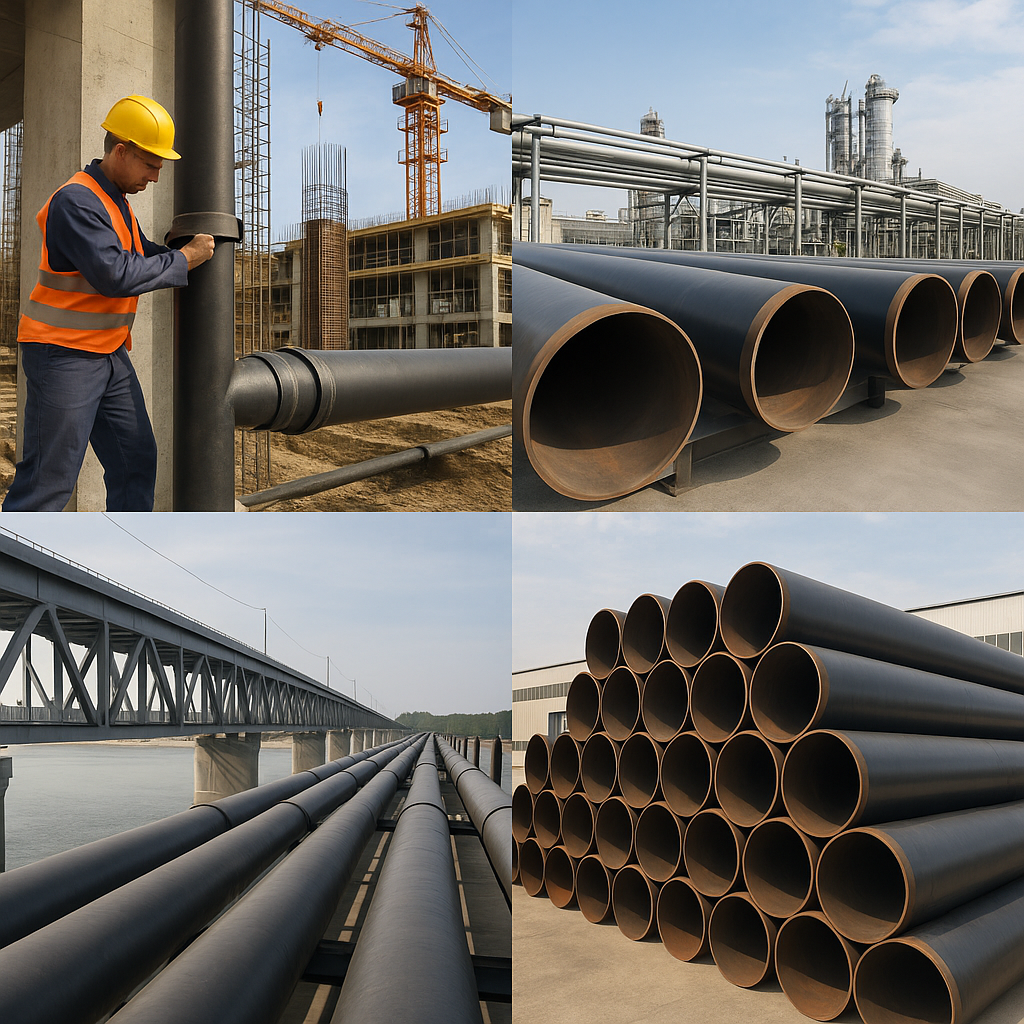In the realm of foundational materials for modern industry and construction, carbon steel pipes play a crucial role as a versatile and widely applicable structural material. With the global manufacturing sector undergoing upgrades, infrastructure development accelerating, energy structures transitioning, and the “dual carbon” strategy driving change, the carbon steel pipe market is undergoing profound transformation. Does carbon steel have the potential for sustained development? Will it be gradually replaced by other materials?

1.Where does the “irreplaceability” of carbon steel pipes come from?
Carbon steel pipes have long held a prominent position among various materials and are widely applied in industries such as industrial, construction, municipal, and energy sectors due to their unique foundational advantages and industrial status:
A.Balanced material properties and strong adaptability
Carbon steel pipes are metal tubes made from carbon steel as the base material, achieving a good balance between strength, toughness, ductility, and weldability:
| Performance Dimensions | Description |
| High strength | Can withstand significant internal and external pressures,widely used in pressure-bearing transportation and structural support |
| Good weldability | Easy to process and connect,suitable for various welding processes |
| Good ductility | Easy to form and bend,suitable for complex installation conditions |
| High wear resistance | Long service life under certain conditions,low maintenance costs |
B.Mature manufacturing processes with significant cost advantages
Carbon steel pipes have a complete production process chain, from steel strip procurement, forming and welding, heat treatment, coating treatment, to inspection and packaging, all of which have been standardized and scaled, bringing significant advantages:
Strong mass production capacity: High-frequency welded pipes/seamless pipes production lines operate efficiently;
Low unit cost: Absolute price advantage compared to stainless steel, copper, composite materials, etc.;
High localization rate: Raw materials and supporting equipment are all domestically sourced;
Intense market competition: Flexible pricing mechanisms and a wide range of customer options.
C.Strong processability, suitable for various subsequent treatments
Carbon steel pipes have excellent secondary processing capabilities and can undergo:
Hot-dip galvanizing / cold galvanizing / anti-corrosion coating;
Punching / Bending / Threading / Flange connection processing;
Customizable length, thickness, and cross-sectional shape (square and rectangular tubes), etc.
This means that carbon steel pipes are not only “raw materials” but also a “semi-finished product platform” that can be highly customized according to project requirements.
D.Wide industry coverage, serving as an “infrastructure-type” material for industry
Carbon steel pipes are deeply integrated into major key industries, truly functioning as the “foundation of industrial infrastructure”:
| Industry Sector | Application Examples |
| Building Structures | Support columns,scaffolding,prefabricated steel components |
| Oil and Gas | Main pipelines for oil and gas transmission,wellhead equipment |
| Power Systems | Transmission tower structures,substation frameworks |
| Water Resources | Main water supply and drainage pipes,pressure water supply pipes |
| Machinery Manufacturing | Chassis tubes, hydraulic tubes,transmission tubes,tractor frames |
| Transportation | Bridge trusses,guardrails,collision prevention devices |
2.The “looming crises” facing carbon steel pipes
Despite their solid foundation, the disadvantages of carbon steel pipes are gradually becoming apparent in the new wave of industrial upgrading, and there is a trend toward replacement in certain scenarios.
A.Material bottlenecks: poor corrosion resistance, heavy weight
Insufficient corrosion resistance: prone to rusting in humid, acidic, alkaline, or salt fog environments, requiring secondary galvanization or coating treatment, which increases costs and construction difficulty;
High self-weight: Compared to aluminum alloy or polymer pipes, carbon steel pipes are heavier, resulting in higher transportation and construction costs;
B.Energy Consumption and Carbon Emissions Issues Are Prominent
The production of carbon steel pipes involves high-energy processes such as blast furnace ironmaking, high-temperature rolling, and welding, which face increasing pressure under the carbon neutrality backdrop. An increasing number of projects require green certification, forcing carbon steel pipe companies to undergo environmental upgrades and cost restructuring.
C.Market Structure Changes and Increasingly Diversified Demand
Slowdown in traditional infrastructure demand: As “new infrastructure” replaces traditional infrastructure, the demand for carbon steel pipes is stabilizing or declining;
Upgraded material requirements in high-end manufacturing: New industries such as rail transit, aerospace, nuclear power, and hydrogen energy require lighter, stronger, and more corrosion-resistant high-performance materials;
Increased demand for systematic product solutions from downstream customers: The traditional “selling pipes” model no longer meets customers’ needs for “comprehensive solutions.”
3.Alternative materials emerging under new technologies and green trends:
In carbon steel pipe applications, the following categories of “potential alternatives” are rapidly gaining traction:
A.Stainless steel pipes: A premium corrosion-resistant upgrade option
Advantages: Superior corrosion resistance, high-temperature tolerance, and long service life;
Application areas: Medical, pharmaceutical, and food industries; marine engineering and chemical equipment; architectural decoration and home furnishings;
Limitations: High cost, difficult to process, not suitable for large-scale infrastructure projects.
B.Plastic and composite material pipes: Lightweight alternatives
Advantages: Lightweight, corrosion-resistant, easy to install, and labor-saving;
Mainstream products: HDPE, PPR, PVC, CPVC, fiberglass composite pipes;
Typical applications: Municipal pipelines, indoor water supply and drainage systems, agricultural irrigation, and chemical liquid transportation;
Disadvantages: insufficient strength, prone to aging, unstable under high temperature and pressure.
C.Emerging metal materials such as aluminum alloy and titanium alloy
Aluminum pipes: widely adopted in aviation and automotive lightweighting, gradually penetrating into home decoration, HVAC, and other fields;
Titanium alloy pipes: extremely high strength-to-weight ratio, primarily used in military, aerospace, and medical fields;
Practical issues: High cost, complex processing, difficult to mass-produce, industry standards not yet unified, high replacement costs.
Summary: The foundational advantages and industrial status of carbon steel pipes make them difficult to fully replace in the short term. In the future, even when faced with challenges from alternatives such as plastics, stainless steel, and composite materials, carbon steel pipes can still achieve upgrades through: material upgrades (high-strength steel, composite steel), process innovations (smart welding, green manufacturing), and scenario matching (integration of structure, transportation, and construction services).
